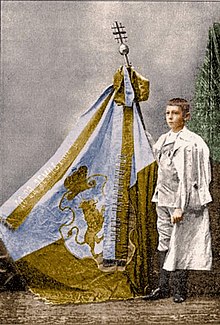
Back الريطونيون Arabic روثينيين ARZ Русіны (гістарычны этнонім) Byelorussian Русіны BE-X-OLD Rutheni Czech Rwtheniaid Welsh Rutenere Danish Ruthenen German Ρουθήνιοι (παλαιό εθνώνυμο) Greek Pueblo ruteno Spanish
 A boy with the pilgrimage flag with the Ruthenian lion during the Ruthenian pilgrimage to the Holy Land in 1906 | |
| Languages | |
|---|---|
| |
| Religion | |
| Predominantly Eastern Orthodox Ruthenian Greek Catholic, Ukrainian Greek Catholic, Russian Greek Catholic Church among other Byzantine rites originally from Slavic origins. | |
| Related ethnic groups | |
| Other East Slavs |
Ruthenian and Ruthene are exonyms of Latin origin, formerly used in Eastern and Central Europe as common ethnonyms for Ukrainians and partially Belarusians, particularly during the late medieval and early modern periods. The Latin term Rutheni was used in medieval sources to describe Eastern Slavs of the Grand Duchy of Lithuania, as an exonym for people of the former Kievan Rus', thus including ancestors of the modern Belarusians, Rusyns and Ukrainians.[1][2] The use of Ruthenian and related exonyms continued through the early modern period, developing several distinctive meanings, both in terms of their regional scopes and additional religious connotations (such as affiliation with the Ruthenian Greek Catholic Church).[1][3][4][5][6]
In medieval sources, the Latin term Rutheni was commonly applied to East Slavs in general, thus encompassing all endonyms and their various forms (Belarusian: русіны, romanized: rusiny; Ukrainian: русини, romanized: rusyny). By opting for the use of exonymic terms, authors who wrote in Latin were relieved from the need to be specific in their applications of those terms, and the same quality of Ruthenian exonyms is often recognized in modern, mainly Western authors, particularly those who prefer to use exonyms (foreign in origin) over endonyms.[7][8][9]
During the early modern period, the exonym Ruthenian was most frequently applied to the East Slavic population of the Polish–Lithuanian Commonwealth, an area encompassing territories of modern Belarus and Ukraine from the 15th up to the 18th centuries.[10][11] In the former Austro-Hungarian Monarchy, the same term (German: Ruthenen) was employed up to 1918 as an official exonym for the entire Ukrainian population within the borders of the Monarchy.[12][13]
- ^ a b Paul Robert Magocsi. "Rusyn". Encyclopedia Britannica. Retrieved 15 May 2023.
- ^ РУСИНЫ [Rusyns]. Большая российская энциклопедия - электронная версия (in Russian). [Great Russian Encyclopedia - electronic version]. Archived from the original on 26 September 2021. Retrieved 15 December 2021.
- ^ Shipman 1912a, p. 276-277.
- ^ Shipman 1912b, p. 277-279.
- ^ Krajcar 1963, p. 79-94.
- ^ Rohdewald, Stefan; Frick, David A.; Wiederkehr, Stefan (2007). Litauen und Ruthenien: Studien zu einer transkulturellen Kommunikationsregion (15.–18. Jahrhundert) [Lithuania and Ruthenia: studies of a transcultural communication zone (15th–18th centuries)] (in German). Wiesbaden: Harrassowitz. p. 22. ISBN 978-3-447-05605-2. OCLC 173071153.
- ^ Himka, John-Paul. "Ruthenians". Internet Encyclopedia of Ukraine.
- ^ Himka 1999, p. 8-9.
- ^ Magocsi 2015, p. 2-5.
- ^ Bunčić 2015, p. 276-289.
- ^ Statute of the Grand Duchy of Lithuania (1529), Part. 1., Art. 1.: "На первей преречоным прелатом, княжатом, паном, хоруговым, шляхтам и местом преречоных земель Великого князства Литовского, Руского, Жомойтского и иных дали есмо: ..."; According to.: Pervyi ili Staryi Litovskii Statut // Vremennik Obschestva istorii i drevnostei Rossiiskih. 1854. Book 18, p. 2.
- ^ Moser 2017–2018, p. 87-104.
- ^ "Magyarország népessége". mek.oszk.hu. Retrieved 24 October 2023.